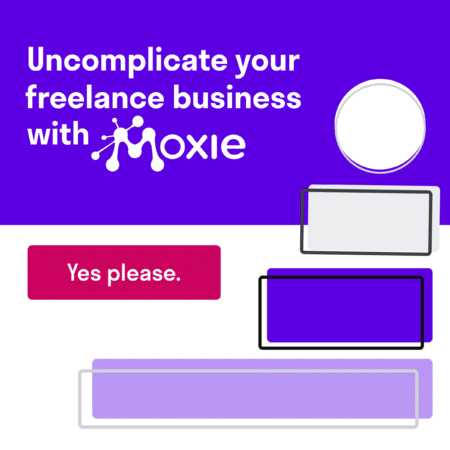We’ve all been there. You get to the end of a project, proudly turn it in to the client, expecting glowing reviews…
And find out you totally missed the mark.
While there’s no surefire way to guarantee satisfied clients, one thing that can help smooth the process for everyone involved is drafting a design brief.
It sounds formal, and it can be, but the point of a design brief isn’t necessarily to dot every i and cross all of the t’s in a project. It’s not a legal contract or a “gotcha” document to avoid necessary revisions.
What a design brief can do, and do really well, is get everyone talking about the same things. You may find that working with a design brief helps generate productive discussions before a project starts. It will help you ask the right questions, establish boundaries, and give both you and the client a firm idea of where things are going.
Beyond that, a design brief will give you confidence as a freelancer, and help you look polished and professional to clients. Anything that helps you stand out is a win, right?
In this article, we’ll explore what a design brief is, how to use one, and give some examples to help get you on the right track.

What is a design brief?
According to the Cambridge Dictionary, a design brief is, “a written description of what a new project or product should do, what is needed to produce it, how long it will take, etc.”
Because it has the word “design” in it, some people mistakenly believe that a design brief is only for, well, designers.
Not true.
A design brief is for any type of project. Writers, website builders, photographers, marketers, interior decorators, programmers, translators, videographers, animators, SEO consultants and yes, graphic designers can all benefit from working off of a design brief.
Think of a design brief as a road map. You’re stating the end goals of the project, and then establishing benchmarks and details to get there. Sure, it’s a bit more work upfront, but it can honestly save so much time, effort and drama on the backend that it is well worth the effort.

For example, let’s consider a graphic designer picking up a high-paying, short term project. They are so excited to dive in and start billing hours that they just go for it, the minute the contract is signed.
Our designer talks with the client on the phone, takes a few notes, and feels like they know what is needed. Being thorough, they visit the client’s website and pull colors, fonts and looks to work off of. They spend ten hours building out a beautiful, full-color brochure and send it off, moving on to their next gig.
The next day, they find out that the brand is changing up their style guide in the next couple of months, and they need an altered set of colors and fonts. And they are switching printers, so the parameters are slightly different than a standard brochure of that size. Our design is looking at several hours of work on what is now a rush job.
It’s not the end of the world, but do you know what would have helped avoid the problem at all? A design brief.
Now let’s consider an app programer who has been contacted to build out an interface from scratch. It’s a long-term, high-stakes job.
The programmer meets with the client and their team, inviting anyone who will be touching the final product to sit in. The programmer is prepared with a template, so they don’t forget to ask important questions like budget constraints, who the end user is, what types of phones the app has to work on, style guidance, etc.
The brief goes back and forth a few times, and the programmer is able to dedicate their time to other projects while the client works out what they really want and eventually signs off on a final design brief.
When the project is complete, there are some minor revisions and one major revision requested. The programmer points back to the design brief to explain why they made the choices they did, and is able to negotiate up-charges for the revisions.

In the end, everyone is satisfied.
How to write a design brief: here’s what to include
That sounds awesome, you are saying to yourself right now––but how do I do it?
There’s no single correct way to write up a design brief. As you use your template with more clients and on more projects, you’ll notice questions you should have asked, or parts of the brief that you don’t really use.
But I can give you a general guideline that should help you get started.
Project overview
The project overview simply states what the project is, with relevant background information. If the project is an update to existing work, that would be important to note here. You should also collect all of the relevant contact information for your clients and provide your own in this section.
Goals/objectives
This is probably the most important section. Most clients tend to overshoot on their expectations. They want a single project to do all. the. things.
Help your client see that a single goal, possibly with some sub objectives, will allow you to focus your energy on what really matters, so that your project ends up accomplishing what it needs to really well.
Target audience
Understanding who the project is for will impact how you create it. For example, writing a blog post is not like writing a press release. An app for children would be totally different than one for a professional conference. The more detail in this section, the better.

Deliverables/Scope of Work
Deliverable and the scope of work should also be in your contract with your client, but including them here helps everyone remember what the end result will be.
If your client brings up things you weren’t expecting to create, it’s much better to get that ironed out and negotiate a new rate now instead of after you’ve finished the work.
Timeline
Deadlines are a fact of life for freelancers, and we’re great at meeting them, because our businesses and reputations rely on it. Having the timeline spelled out in a design brief will help your client see approximately where you’re at in the process without having to text you three times/day.
That isn’t the only thing you should stress in this section, however. Clients are so often the hold up in their own projects. Showing them a visual or written out timeline can help them understand what information or materials they will need to provide and when.
This can help avoid those long waiting periods and clients dodging your emails because they are so swamped.
Budget
No design brief is completed without a detailed budget. This includes your billable rate, materials budget, and agreements for overages. If there will be other contractors involved those fees may be included in the same design brief, or you can keep them separate, depending on how closely you’ll be working together.
Be sure to include things like travel expenses, equipment, fees, or other things that might pop up. Things that aren’t included in the original budget can also be listed, so the client knows what will cost them extra. This will help you avoid scope creep.
Design brief example to use
Sometimes it helps to actually see all of the information together, so here’s an idea of what a design brief might look like. Feel free to use this template in your own projects.
Design Brief
Date: 6/14/21
Project Title: Freelance Worker’s Union Logo Design
Project Overview:
The Freelance Worker’s Union (FWU) is a new organization, hoping to attract members to help in collectively lobbying congress on issues of importance to contract workers.
They request a new logo for placement on all materials going forward.
| Primary Client Contact | Name: |
| Email: | Phone: |
| Best way to contact: | Best time to contact: |
| Secondary Client Contact | Name: |
| Email: | Phone: |
| Best way to contact: | Best time to contact: |
Goals/Objectives:
- Convey a sense of professionalism and community that will attract members across print and digital platforms.
- Stand out on social media
- Define the style and color palette of the organization
Target Audience:
- Freelance professionals across a variety of industries
- Particularly Gen Z and Millennials with energy to effect change
- Membership will be limited to the United States
- Social media savvy individuals
- Income level not a factor
- Want to reach professionals from all political parties
Deliverables/Scope of Work:
- Three rough concepts for client to choose final design from
- Designs should incorporate the name of the organization (Freelance Worker’s Union)
- Two versions of the final logo design (If further versions, such as a stacked concept, are desired, this will require a new project agreement.)
- One full-color
- One grayscale
- As there is no existing brand, colors and fonts to be determined by designer
- Final RGB, CMYK and hexadecimal values of all colors included in a separate file from the art file
- Final art files including .AI and high-res PNG, JPG and SVG versions
Timeline:
- All work to be completed no later than June 5th.
- Initial concepts due no later than May 20th.
- Final client choice due May 25th.
- Final designs to be submitted to client May 31st.
- Client feedback required by Jun 2nd.
- Final art files delivered by June 5th.
- Payment due upfront.
Budget:
The budget for this project is $550. This includes a virtual client consultation, designer labor, up to two rounds of revision of the final files, and up to five followup meetings via phone as necessary.
Additional consultations and revisions will be billed at a rate of $65/hour.
Printing costs and in-person meetings are not included.
SOURCE: TheFreelanceFiles.com
Conclusion
A design brief can be the difference between a satisfying client relationship and total chaos and frustration.
Coming armed to your initial client meeting with a high-quality design brief template will help you feel professional and prepared. The more experience you gain with using a design brief, the faster the process will go and the more fine-tuned your document will get.
Keep the conversation going...
Over 10,000 of us are having daily conversations over in our free Facebook group and we'd love to see you there. Join us!

